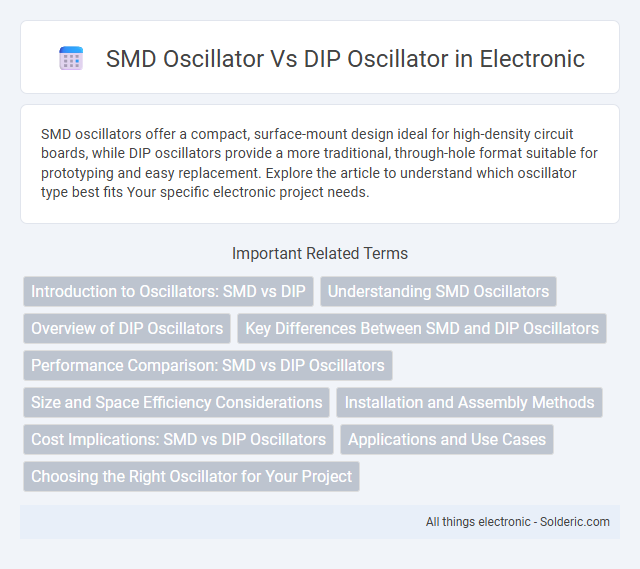SMD oscillators offer a compact, surface-mount design ideal for high-density circuit boards, while DIP oscillators provide a more traditional, through-hole format suitable for prototyping and easy replacement. Explore the article to understand which oscillator type best fits Your specific electronic project needs.
Comparison Table
| Feature | SMD Oscillator | DIP Oscillator |
|---|---|---|
| Package Type | Surface Mount Device (SMD) | Dual In-line Package (DIP) |
| Mounting Method | Surface-mount technology (SMT) | Through-hole mounting |
| Size | Compact, low profile | Larger footprint |
| Frequency Range | Typically 1 MHz to 200 MHz | Typically 1 MHz to 50 MHz |
| Power Consumption | Lower due to efficient design | Higher power consumption |
| Reliability | Good mechanical stability | Robust but prone to mechanical stress |
| Application | Modern high-density PCB designs | Legacy and prototype circuits |
| Cost | Generally lower in mass production | Higher due to manual assembly |
| Signal Stability | Stable under various conditions | Stable, but more sensitive to vibration |
Introduction to Oscillators: SMD vs DIP
Surface-mount device (SMD) oscillators offer compact design and ease of automated assembly compared to dual in-line package (DIP) oscillators, which are bulkier but provide straightforward manual installation and prototyping advantages. SMD oscillators typically deliver higher reliability and better performance at high frequencies due to reduced lead inductance and parasitic capacitance. Choosing between SMD and DIP oscillators depends on your project's size constraints, manufacturing process, and frequency requirements.
Understanding SMD Oscillators
SMD oscillators are surface-mounted devices designed for compact circuit boards, offering high-frequency stability and reduced electromagnetic interference compared to DIP oscillators. Their small size and lighter weight enable efficient automated assembly, making them ideal for modern portable electronics and high-density applications. These oscillators typically provide better performance in terms of signal integrity and thermal management within tightly packed PCB layouts.
Overview of DIP Oscillators
DIP oscillators are packaged in Dual In-line Packages, offering easy integration into through-hole PCB designs with reliable mechanical stability. These oscillators provide stable frequency generation, commonly used in applications requiring robust environmental tolerance and straightforward mounting. You can choose DIP oscillators for projects where durability and simple replacement are essential, contrasting with the more compact, surface-mounted SMD oscillators.
Key Differences Between SMD and DIP Oscillators
SMD oscillators are surface-mount devices designed for compact PCB layouts, offering lower profile, reduced parasitic inductance, and better high-frequency performance compared to DIP oscillators, which are through-hole components generally larger and easier to handle manually. DIP oscillators provide enhanced mechanical robustness and simpler prototyping but at the cost of increased size and slower signal transitions due to longer lead lengths. The choice between SMD and DIP oscillators depends on factors like board space constraints, frequency stability requirements, and manufacturing processes.
Performance Comparison: SMD vs DIP Oscillators
SMD oscillators offer superior performance compared to DIP oscillators through their smaller parasitic capacitance and inductance, resulting in lower phase noise and higher frequency stability. The compact size and surface-mount design of SMD oscillators enhance thermal dissipation and reduce signal path length, improving overall signal integrity at high frequencies. DIP oscillators, while easier to handle and replace, generally exhibit higher power consumption and larger footprint, which limits their use in high-density, performance-critical applications.
Size and Space Efficiency Considerations
SMD oscillators are significantly smaller than DIP oscillators, offering better space efficiency for modern compact electronic devices. The surface-mount design enables these oscillators to be mounted directly onto the PCB, reducing overall footprint and allowing for higher component density. DIP oscillators, being larger and requiring through-hole mounting, are less suitable for applications with stringent size constraints.
Installation and Assembly Methods
SMD oscillators are designed for surface-mount technology (SMT), enabling automated PCB assembly with higher precision and reduced space consumption, which streamlines mass production processes. DIP oscillators require through-hole mounting, involving manual insertion or wave soldering, making them suitable for prototyping or applications where mechanical stability is critical. The choice between these oscillators impacts manufacturing efficiency, with SMD oscillators favoring high-volume, compact designs and DIP oscillators supporting easier handling and rework.
Cost Implications: SMD vs DIP Oscillators
SMD oscillators generally offer lower production and assembly costs due to their compatibility with automated surface-mount technology, reducing labor expenses. DIP oscillators tend to have higher manufacturing costs because of manual handling and through-hole mounting processes. Budget-conscious projects prioritize SMD oscillators as cost-effective solutions while maintaining performance standards.
Applications and Use Cases
SMD oscillators are widely used in compact electronic devices such as smartphones, wearables, and IoT gadgets due to their small size and surface-mount compatibility, enabling high-frequency stability in tightly packed circuit boards. DIP oscillators find applications in prototyping, test equipment, and legacy systems where easy handling, socket compatibility, and manual replacement are essential. Your choice between SMD and DIP oscillators depends on the device's form factor requirements and the need for easy maintenance or compact integration.
Choosing the Right Oscillator for Your Project
SMD oscillators offer compact size and superior performance for high-frequency applications, making them ideal for modern, space-constrained PCBs. DIP oscillators provide ease of handling and prototyping flexibility, suitable for development stages or projects requiring robust mechanical stability. Consider your project's size constraints, frequency stability needs, and manufacturing volume when choosing the right oscillator for your design.
SMD oscillator vs DIP oscillator Infographic

 solderic.com
solderic.com